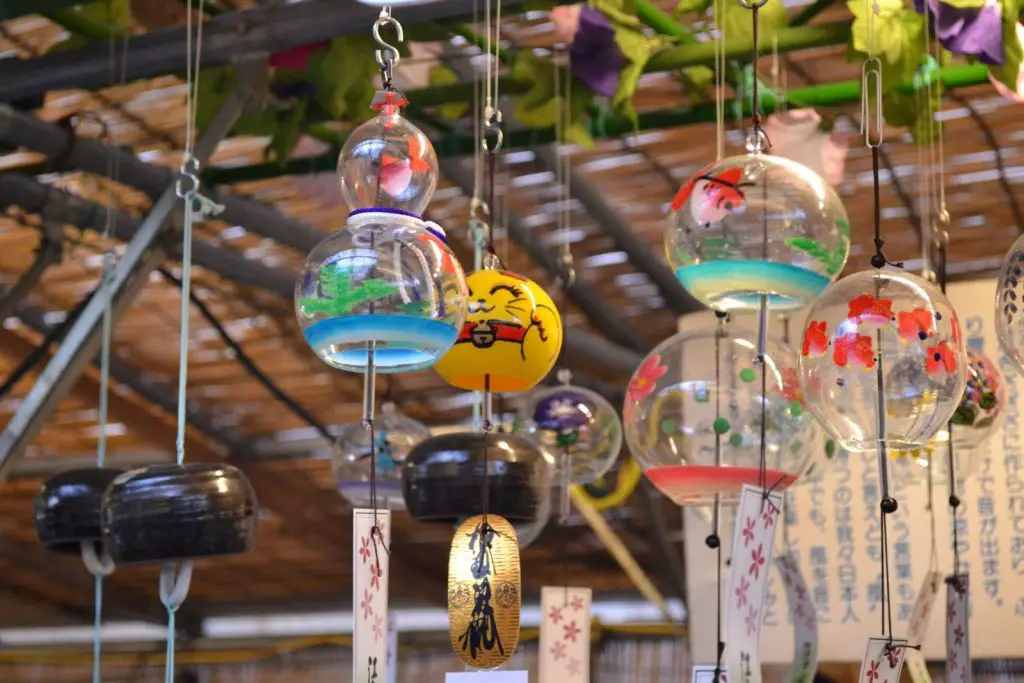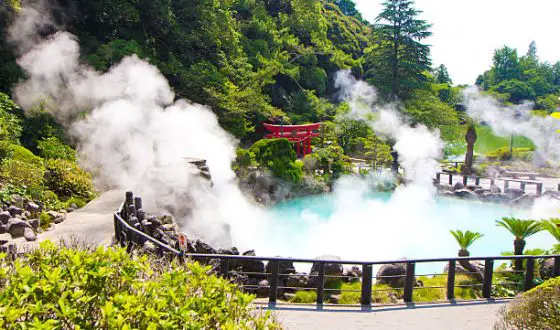Japanese Wind Chimes – A Characteristic Symbol of Japan
Strolling around somewhere in Japan, you may hear the beautiful soothing sounds of Japanese wind chimes or furin which is one of the most characteristic symbols of the Japanese summer. Being used as decorations, furin also has its own history and several meanings. To know more about this stunning ornament, read this blog now!
1. The History of The Japanese Wind Chimes
Wind chimes were originally a fortune-telling tool in China. The Chinese hung a bell in the bamboo forest and made predictions based on the wind’s direction and its sound. However, since they’ve arrived in Japan through Buddhism, they perform other functions.
In the old days in Japan, it was believed that whenever there was a strong wind, an epidemic would happen. Therefore, a bell-shaped bronze wind chime called the futaku was hung up to avoid epidemics and ward off evil.

In the ancient times, Japanese wind chimes were believed to ward off epidemics and evil
When the futaku gets blown by a strong wind, it produces a sound that makes people aware of the wind as well as any changes happening around them. These Japanese bells were mainly hung in sacred places such as shrines and temples, giving people a peaceful feeling.
Japanese wind chimes were first made of bronze, but towards the 18th century, Dutch glass making techniques were introduced into Japan and changed not only the material but also the sound and design of the furin. Thus, Japanese glass wind chimes now become much more gentle and elegant.

At first, bronze is the main material to make wind chimes
Although the furin was traditionally used to ward off evil and epidemics, nowadays Japanese people simply enjoy its refreshing sound during hot and humid summer days. For some people, the relaxing sound of the furin combined with the sound of the Japanese cicada eases the summer heat.

Nowadays, people simply enjoy the relaxing sound of wind bells during summer days
SEE MORE:
2. Parts Of A Furin
The furin consists of three parts which are the bowl-shaped exterior, the zetsu (clapper) on the inside that produces the sound, and a strip of paper that is hung from the zetsu. With just these parts, the furin is able to emit the beautiful sound that is reminiscent of the Japanese summer.

Consisting of just three parts, Japanese wind chimes are able to emit the beautiful sound that is reminiscent of the Japanese summer
3. How Are Japanese Wind Chimes Made?
The basic shape of a glass wind chime is created by traditional glass crafting techniques. Firstly, the heated glass is blown up to the size of a large candy. Then, after collecting melted glass by spinning it, the glass is shaped into a bowl. While adding more air, a hole to put the thread for hanging is made. Lastly, a picture is painted onto the inside of the cooled glass to complete the furin.
In Japan, some regions have their own techniques for making wind chimes. For example, in Iwate prefecture, traditional Nambu iron techniques are used to make the Nambu Furin. Despite the heavy appearance, the clean metallic sounds it creates has its own charm. In Toyama Prefecture, furin is made using the Takaoka Bronze. Okinawa uses their famous Ryukyu Glass to create theirs.

Here come the Nambu furin made by traditional Nambu iron techniques
Depending on people’s liking, Japanese wind chimes are used for many purposes and in many different ways. Some people simply use them to decorate their rooms, bringing a Japanese sort of feel to their houses.
4. The Meaning Of The Paper Hanging From The Furin
Hung from the center of the furin is a piece of paper. When the wind blows, the paper catches the wind and moves the clapper to produce the sound which is so gentle that makes everyone enjoy during summer months.
Besides, the paper also helps to enhance the feeling of a summer breeze. We can even see the wind when the paper moves from a light breeze. It is the secret of how to feel cool even on the hot and humid days of the Japanese summer.

The paper hung from the furin not only helps to produce the sound but also makes people feel the presence of the wind
5. How To Buy Wind Chimes In Japan
If you would like to buy Japanese wind chimes for your own, you had better go to the Fujiwara Fūrin Main Shop. This shop is a twelve-minute walk from Mizue Station on the Toei Shinjuku Line and has been operating for over one hundred years. Visiting the shop, you may have a chance to see how furin is being made and experience making one yourself. If you are interested in these activities, feel free to contact them.
You can purchase the popular souvenir of Iwate which is the Nambu iron furin at the Mizusawa Ward in Oshu city. If you visit Mizusawa Station in the summer, you will find many Nambu furin on display at the waiting room in the station.
During the summer is the period that you can easily buy wind chimes in Japan. Wind chime shops from all over the nation are likely to have pop-up booths to sell their originals. Traditional shopping areas such as Asakusa in Tokyo will have a variety of traditional and original wind chimes as well.

It is easiest to buy wind bells during the summer
6. Tip To Choose Your Ideal Wind Bell
Choose your ideal wind bell based on material, design, color and sound. If you cannot find the perfect one, order a DIY glass or ceramic chime to paint yourself!
Would you like to listen to the sound of Japanese wind chimes? Watch this video now!
Conclusion
Now that you have known what a furin or Japanese wind chime is, how it is made, where to buy it as well as its meanings. If you go to visit Japan one day, you can consider buying Japanese wind chimes as souvenirs or gifts for your families and friends. For more useful information about Japan or things like wind bells, please keep following Question Japan!









